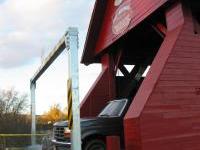In this age of cement and steel, the massive Marchand covered bridge in Fort Coulonge seems a throwback to an earlier time, a time when building a covered bridge, even one of this magnitude, was a common occurrence.
Built by Augustus Brown in 1898, for Quebec’s Department of Colonization and Mines, and spanning the Coulonge River, the bridge cost about $6,000 (not including paint). Its six spans measured an astounding 499 feet (152 metres). The technique used for the structure was a rare combination of Town lattice and Queenpost trusses, a combination that rendered the bridge extremely sturdy. It was meant to last!
ONE OF QUEBEC’S OLDEST COVERED BRIDGES
At 108 years of age and counting, the Marchand Bridge is one of the oldest covered bridges in Quebec. Indeed, only covered bridges found in the Eastern Townships and the Chateauguay Valley are older.
LONGEST COVERED BRIDGE IN QUEBEC?
At 499 feet (152 metres), the Marchand Bridge is also (arguably) the longest covered bridge in Quebec. In fact, only one other covered bridge in the province comes anywhere close, the Perreault Bridge at Notre-Dame-des-Pins in the Beauce. Like the Marchand Bridge, the Perreault Bridge claims the title of Quebec’s longest covered bridge. At 495 feet (151 metres), it actually measures one metre shorter than the Marchand Bridge.
Where disagreement arises is that Marchand’s total length includes the distinctive “jets” that project outward at each end of the bridge, and which protect the ends of the structure from rain and snow. The Ministry of Transport, on the other hand, bases its measurements solely on the total length of a bridge’s lower weight-bearing chord!
One thing is certain, as Gérald Arbour et al. state in their book on Quebec’s covered bridges, Les ponts couverts au Québec, the Marchand Bridge can at the very least claim to be the longest covered bridge in use in the province, and the Perreault Bridge, the longest covered bridge is no longer in use.
FLOODS, LOG JAMS, AND OTHER THREATS
The Marchand Bridge has at times led a precarious existence. Over the last century, it has been periodically racked by springtime flooding, log jams, and other threats. On a number of occasions, the piers beneath the bridge have suffered serious damage; more than once, the structure above has been threatened with destruction.
In the 1950s, increasing truck traffic in Fort Coulonge necessitated the construction of a modern cement bridge further downstream. In the 1960s, the municipality decided that, in light of the new bridge, the covered bridge no longer warranted expensive upkeep. The decision was taken to demolish the bridge.
According to Arbour et al., a popular outcry ensued. It was one of the first instances on record where public opinion was actually able to convince local politicians to change their minds and repair a bridge instead of tearing it down. Accordingly, the old bridge received the necessary repairs and things continued as before.
In 1979, a nearly disastrous build-up of ice on the Coulonge River almost destroyed the bridge once and for all. Pressure from huge blocks of ice twisted the bridge out of shape and partly off of its piers. All was nearly lost. Fortunately crews were able to conduct emergency repairs to stabilize the structure, and the span was closed to traffic for a year.
HISTORIC MONUMENT
Repaired and returned to position during the winter, the bridge was re-opened to traffic in 1980. In 1988, it was declared a historic monument by the province of Quebec. Today, it is one of the most recognized historic landmarks in the Pontiac, and a gem of Quebec’s built heritage. Passers-by cannot help but admire the splendid sight of the enormous span, painted from end to end in dazzling red. Sometimes, the urge to venture inside is overpowering. By foot or by car, the trip across is impressive, for rarely (if ever) does one get the chance to cross a covered bridge this long!
References:
Gérald Arbour et al., Les ponts couverts au Québec, 2005.
Gérald Arbour, Les ponts rouges du Québec, 1999.